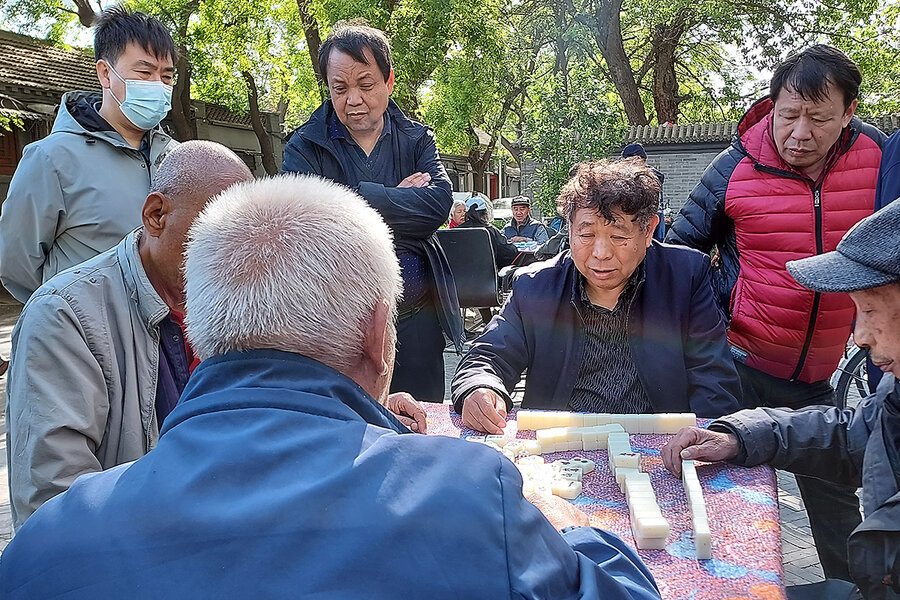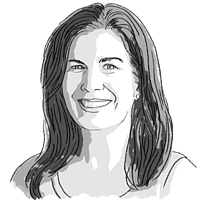Back in Beijing, without big white suits
Loading...
| Beijing
The Monitor’s Beijing correspondent, returning to Beijing for the first time since China ended its severe pandemic lockdowns, knew things had changed as soon as her plane landed.
No inspectors boarded the aircraft. And in the terminal there were no more “da bai” or “big white” – the hazmat-suited workers who used to herd travelers to cubicles for deep-nostril COVID-19 tests, corral them for hours of screening, and then take them on long bus rides to mystery hotels for quarantine behind alarm-triggering doors.
Why We Wrote This
A story focused onFreed from harsh COVID-19 restrictions, Chinese people are living normal lives again. And discovering the possibilities to be found in an unmasked smile.
Our reporter, Ann Tyson, simply took a taxi home. And the next morning she found that her residential compound was hosting a fair for local businesses, complete with music, games, handicrafts, and limbo dancing.
It was a far cry from the silent, hunkered-down city she had left in December, which had lived for nearly three years under the harshest anti-COVID-19 restrictions in the world.
In a restaurant, none of the customers was wearing a mask; none had to display their negative COVID-19 status.
At last, Ann writes, she and her neighbors have “an opportunity captured in the unmasked smile of a stranger: that invitation to strike up a conversation, say hello, or simply to smile back.”
Peering through the jet window at overcast skies as Beijing’s outskirts emerge below, I run through a mental checklist.
Before leaving the United States to return to China, I took two COVID-19 tests instead of the one required – just in case. Ditto for the Chinese customs health declaration. I updated the electronic form while changing planes in Taiwan to make sure it wouldn’t expire.
Having lived in China under its draconian “zero-COVID” policy, I am programmed to arm myself with extra documentation to get through China’s multilayered pandemic control bureaucracy.
Why We Wrote This
A story focused onFreed from harsh COVID-19 restrictions, Chinese people are living normal lives again. And discovering the possibilities to be found in an unmasked smile.
Now, all that bureaucracy has gone. Last December, China’s leaders abruptly lifted many of the restrictions amid mounting social unrest and economic stagnation. China’s doors would open wide to the world, its leaders pledged.
But after three years of mandatory quarantines, mass testing, and lockdowns – would China really be back to “normal,” I wonder? What would that look like? What would it feel like?
The pilot lands and taxies to the gate. When attendants open the cabin doors, no health officials board the plane to inspect us. It is the first of many things that, happily, do not happen.
The terminal is no longer filled with “da bai” or “big white” – the hazmat-suited workers who used to herd travelers to cubicles for deep-nostril COVID-19 tests, corral them for hours of screening, and then take them on long bus rides to mystery hotels for quarantine behind alarm-triggering doors.
Fingerprinting is back, but customs and immigration procedures are otherwise unremarkable. No one looks at my two COVID-19 test reports. I hail a taxi and head for the Monitor’s bureau in downtown Beijing.
At midafternoon, traffic is already heavy – a big change from “zero-COVID” days, when lockdowns turned vast cities such as Beijing and Shanghai, each home to over 20 million people – into deserted ghost towns.
“This traffic is actually light,” the driver tells me. “Just wait until rush hour!” Asked about masks, he answers nonchalantly: “You can wear one or not – it’s up to you.”
No more COVID-19 test lines
The next morning at the Beijing apartment block that houses the Monitor’s bureau, a loud pulse of Chinese electronic dance music rises from the central courtyard.
A large fair is underway, with live music, games, booths for local businesses, vendors selling crafts, specialty foods, and even cars. A clown twists balloons into animal shapes, while children do the limbo and a few adults dance.
This scene would have been unimaginable a few months ago. Back then, most gatherings were banned and life in residential compounds was dominated by daily COVID-19 directives carried out by neighborhood committees – the lowest branch of governance in China. Committee members in hazmat suits acted as enforcers – advising residents when to test, regulating who came and went, and imposing lockdowns as needed. Each morning, I would look down into the courtyard below to see how long the COVID-19 testing line was.
Now, I head downstairs to check out the market, sampling Chinese pastries and talking with vendors.
Iris Liu is handing out toy airplanes to children and promoting her travel business, which she is working to revive after it was effectively shut down when China closed its borders to tourists.
“I was lucky – I got pregnant” at the start of the pandemic, says Ms. Liu, head of Beijing Infinity International Travel Service. “So of the three years China was closed during ‘zero-COVID,’ I spent one in pregnancy and two taking care of my son.”
But after living on her savings and scrimping to get by, she’s now urgently looking for customers. China is “opening up gradually,” she says, explaining how Beijing is relaxing controls according to its relations with different countries. The government reinstated tourist visas and began allowing group tours last month.
The revival of people-to-people exchanges comes as China’s top leaders engage in a flurry of diplomacy to shore up Beijing’s influence and woo foreign business. The country’s image suffered during the pandemic; they are broadcasting a simple message: China is back.
Beijing busy again
Venturing out into the city by bicycle, I immediately notice how alive the streets feel as I weave between delivery carts, cars, other cyclists, and pedestrians.
Construction workers and suited businessmen, shoppers and young movie fans snapping up tickets to this week’s Beijing International Film Festival – all bring a sense of drive to the streets of the capital.
Parents crowd around a gate to pick up their children from kindergarten – a school that was closed when I was here last. Countless small businesses, from noodle shops to bathhouses to boutiques – have reopened since the dark, somber days of winter when the city hunkered down as it was engulfed by a wave of illness.
A resurgence of consumer spending has buoyed China’s economy, which bounced back during the first quarter of this year with 4.5% GDP growth – the fastest rate in a year. The International Monetary Fund projects China’s economic growth will surpass 5% this year.
I meet friends at a hot-pot restaurant jammed with diners. No longer do I need to register to enter the restaurant by scanning my individual health QR Code – an app on my cellphone that tracks my location and rates my COVID-19 health status as green (normal), yellow (must test), or red (must quarantine). Curious, I check and see if my code still works – it does, and it is green.
Inside, no one except for the waitresses and waiters are wearing masks. Beijing relaxed its stringent mask mandate two weeks ago, no longer requiring the face coverings in most indoor settings, including public transportation.
Gathering around steaming cauldrons of broth, the diners are enjoying the lively atmosphere – Chinese call it renao, literally “hot and noisy” – and a man at the next table calls out to ask if we’ve eaten here before.
Getting back to being social
It strikes me just how much such interactions had been dampened in recent years by social distancing mandates and propaganda-stoked fears of infection, which in China meant weeks of quarantine and carried a significant stigma.
Whether it’s with a group of old men playing chess on the street corner who invite me to sit down beside them to watch the game, or with a Chinese professional woman whom I meet in the neighborhood and spend hours getting to know over tea – there is a revived and refreshing spontaneity to social contacts.
And as people come out of their pandemic shells, they are reflecting on the profound experience they’ve just lived through – and wondering what the future may bring. They are asking questions and comparing notes – like the man who sat down next to me at the tiny neighborhood haircut shop, down a traditional alley, or hutong, near where I live.
“Do you think China’s COVID policy was correct?” he asks me, engaging in a free-flowing back-and-forth as we sit side by side in the barber chairs.
For some Chinese, the pandemic was a traumatic ordeal; long, unpredictable lockdowns harmed their mental health and stirred a desire to leave the country. Others defend the government’s harsh COVID-19 policy as the best approach for China.
But all of us have a new chance to explore these topics, and many more. It’s an opportunity captured in the unmasked smile of a stranger – that invitation to strike up a conversation, say hello, or simply smile back.










